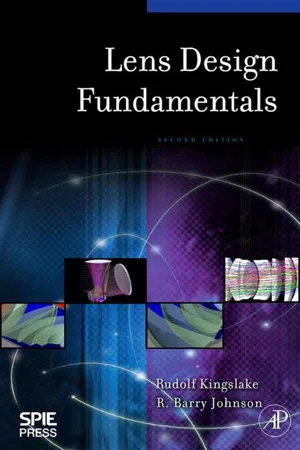
Lens Design Fundamentals
Rudolf Kingslake,R. Barry Johnson
- 569 páginas
- English
- ePUB (apto para móviles)
- Disponible en iOS y Android
Lens Design Fundamentals
Rudolf Kingslake,R. Barry Johnson
Información del libro
- Thoroughly revised and expanded to reflect the substantial changes in the field since its publication in 1978
- Strong emphasis on how to effectively use software design packages, indispensable to today's lens designer
- Many new lens design problems and examples – ranging from simple lenses to complex zoom lenses and mirror systems – give insight for both the newcomer and specialist in the field
Rudolf Kingslake is regarded as the American father of lens design; his book, not revised since its publication in 1978, is viewed as a classic in the field. Naturally, the area has developed considerably since the book was published, the most obvious changes being the availability of powerful lens design software packages, theoretical advances, and new surface fabrication technologies.
This book provides the skills and knowledge to move into the exciting world of contemporary lens design and develop practical lenses needed for the great variety of 21 st -century applications. Continuing to focus on fundamental methods and procedures of lens design, this revision by R. Barry Johnson of a classic modernizes symbology and nomenclature, improves conceptual clarity, broadens the study of aberrations, enhances discussion of multi-mirror systems, adds tilted and decentered systems with eccentric pupils, explores use of aberrations in the optimization process, enlarges field flattener concepts, expands discussion of image analysis, includes many new exemplary examples to illustrate concepts, and much more.
Optical engineers working in lens design will find this book an invaluable guide to lens design in traditional and emerging areas of application; it is also suited to advanced undergraduate or graduate course in lens design principles and as a self-learning tutorial and reference for the practitioner.
Rudolf Kingslake (1903-2003) was a founding faculty member of the Institute of Optics at The University of Rochester (1929) and remained teaching until 1983. Concurrently, in 1937 he became head of the lens design department at Eastman Kodak until his retirement in 1969. Dr. Kingslake published numerous papers, books, and was awarded many patents. He was a Fellow of SPIE and OSA, and an OSA President (1947-48). He was awarded the Progress Medal from SMPTE (1978), the Frederic Ives Medal (1973), and the Gold Medal of SPIE (1980).
R. Barry Johnson has been involved for over 40 years in lens design, optical systems design, and electro-optical systems engineering. He has been a faculty member at three academic institutions engaged in optics education and research, co-founder of the Center for Applied Optics at the University of Alabama in Huntsville, employed by a number of companies, and provided consulting services. Dr. Johnson is an SPIE Fellow and Life Member, OSA Fellow, and an SPIE President (1987). He published numerous papers and has been awarded many patents. Dr. Johnson was founder and Chairman of the SPIE Lens Design Working Group (1988-2002), is an active Program Committee member of the International Optical Design Conference, and perennial co-chair of the annual SPIE Current Developments in Lens Design and Optical Engineering Conference.
- Thoroughly revised and expanded to reflect the substantial changes in the field since its publication in 1978
- Strong emphasis on how to effectively use software design packages, indispensable to today's lens designer
- Many new lens design problems and examples – ranging from simple lenses to complex zoom lenses and mirror systems – give insight for both the newcomer and specialist in the field
Preguntas frecuentes
Información
The Work of the Lens Designer
1.1 RELATIONS BETWEEN DESIGNER AND FACTORY
1.1.1 Spherical versus Aspheric Surfaces
Índice
- Cover image
- Title page
- Table of Contents
- Copyright page
- Dedication
- Preface to the Second Edition
- Preface to the First Edition
- A Special Tribute to Rudolf Kingslake
- Chapter 1: The Work of the Lens Designer
- Chapter 2: Meridional Ray Tracing
- Chapter 3: Paraxial Rays and First-Order Optics
- Chapter 4: Aberration Theory
- Chapter 5: Chromatic Aberration
- Chapter 6: Spherical Aberration
- Chapter 7: Design of a Spherically Corrected Achromat
- Chapter 8: Oblique Beams
- Chapter 9: Coma and the Sine Condition
- Chapter 10: Design of Aplanatic Objectives
- Chapter 11: The Oblique Aberrations
- Chapter 12: Lenses in Which Stop Position Is a Degree of Freedom
- Chapter 13: Symmetrical Double Anastigmats with Fixed Stop
- Chapter 14: Unsymmetrical Photographic Objectives
- Chapter 15: Mirror and Catadioptric Systems
- Chapter 16: Eyepiece Design
- Chapter 17: Automatic Lens Improvement Programs
- Appendix: A Selected Bibliography of Writings by Rudolf Kingslake
- Index